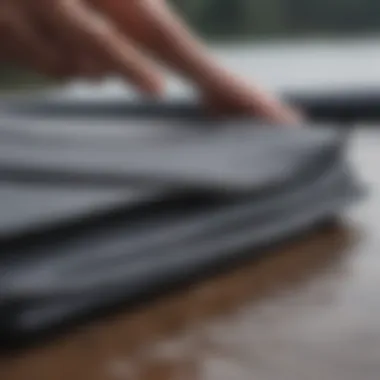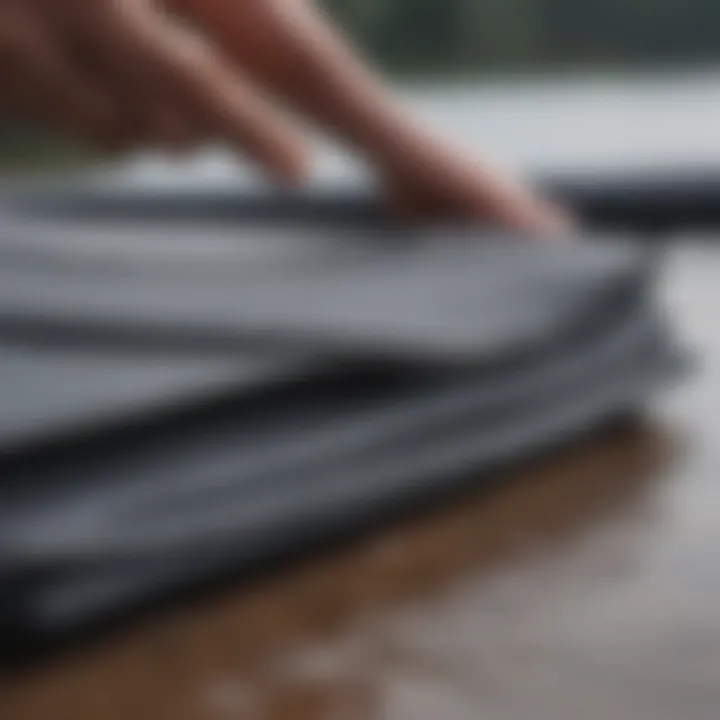Neoprene Thickness Guide for Water Sports Gear


Intro
Understanding neoprene thickness is more critical than most people realize, especially for those who find their thrill in watersports. Whether you're shredding waves on a surfboard or exploring the depths of a lake while kayaking, the right thickness of neoprene can dramatically enhance your experience. It affects not just thermal insulation but also buoyancy and the overall performance of the gear. In this guide, we will break down the nuances of neoprene thickness to help you make an educated choice when selecting your watersport gear.
Techniques and Skills
Fundamental Techniques for Beginners
For beginners stepping into the watersport realm, knowing how to choose the right neoprene suit is just as crucial as mastering the technical skills of the sport itself. Here are some fundamental practices to keep in mind:
- Fit Matters: Ensure the suit fits snugly but isn’t rigid. A proper fit maximizes insulation without restricting movement.
- Thickness Selection: Depending on the climate and water temperature, neoprene thickness usually ranges from 2mm to 6mm. For warmer waters, thinner suits are appropriate, whereas colder venues require thicker options for adequate insulation.
- Layering Technique: In frigid conditions, wearing a thinner 3mm suit layered under a 5mm can offer flexible warmth, keeping you agile without sacrificing warmth.
Advanced Skills for Experienced Athletes
Experienced athletes understand that their performance hinges on the fine details, including the right neoprene thickness. Here’s what they often focus on:
- Precision Fit: Tailored, custom-fit suits can make a world of difference. When your gear mirrors your body, you achieve better performance in the water.
- Material Knowledge: Not all neoprene is created equal. Athletes often learn to identify the subtle differences between closed-cell and open-cell neoprene, which affect buoyancy and heat retention.
- Performance Testing: Regular testing of your gear can reveal how different thicknesses impact agility and endurance during your activities, allowing for optimization as skillsets evolve.
"When you're cutting through the waves, every detail matters—from the suit you wear to the technique you employ. Neoprene thickness is often the unsung hero of great performance."
Safety and Gear
Essential Safety Measures in Watersports
Navigating the waters safely is non-negotiable. Here are significant measures every watersport enthusiast should take:
- Wear a Life Jacket: Always pair your neoprene suit with a properly fitted life jacket, regardless of your swimming ability.
- Know the Weather: Weather conditions can rapidly change. Always check forecasts to avoid unexpected occurrences that could jeopardize your safety in the water.
- Buddy System: Practicing the buddy system isn’t just for fun; it’s a vital safety precaution that ensures someone is always there to help in case of emergencies.
Gear Reviews and Recommendations
Upon delving into the world of neoprene suits, you’ll encounter a variety of brands that offer differing thicknesses and materials. Here's a quick overview of some popular choices among watersport enthusiasts:
- O'Neill Psycho Tech: Known for its flexibility and warmth, perfect for colder conditions.
- Rip Curl Flashbomb: Often cited for its quick-dry technology and performance in various waters.
- Billabong Revolution: A solid option featuring eco-friendly materials without skimping on durability and insulation.
Selecting the right gear and applying the right techniques contribute greatly to optimizing your watersport experience. Armed with this knowledge on neoprene thickness and its implications, you are better positioned to make informed choices, ensuring that every dive into the waves is both enjoyable and safe.
Prelude to Neoprene
When it comes to watersports, understanding the materials that make up your gear can be just as crucial as mastering the techniques themselves. Neoprene is one such material that holds immense significance, serving as the backbone of many equipment choices. From wetsuits to accessories like boots and gloves, this synthetic rubber plays a vital role in keeping enthusiasts safe and comfortable in various aquatic settings.
One of the key advantages of neoprene is its ability to provide insulation while allowing flexibility. This means that users can enjoy optimal warmth without sacrificing movement. As each water sport demands specific performance levels, appreciating the nuances of neoprene can directly translate into a better overall experience on the water.
Moreover, neoprene comes in various thicknesses, each suited for distinct conditions and activities. Whether you're surfing in chilly waters or kayaking during warmer months, knowing the right thickness can make all the difference. This section aims to shed light on what neoprene is and its essential properties, paving the way for a deeper understanding of how to select the ideal gear for your needs.
What is Neoprene?
Put simply, neoprene is a type of synthetic rubber derived from polychloroprene. This material is primarily known for its superior elasticity, water resistance, and durability, making it a popular choice for all kinds of watersport gear. Unlike natural rubber, neoprene doesn't degrade as quickly when exposed to sunlight and various weather conditions, extending its lifespan significantly.
Neoprene's unique composition provides a closed-cell structure that traps tiny water pockets. These pockets provide insulation, effectively maintaining body heat when submerged in colder environments. It's like wearing a cozy blanket in the water—when you know how to choose thickness accordingly.
Properties of Neoprene
Understanding neoprene goes beyond its basic definition; its properties are what set it apart. Here are some key attributes to consider:


- Insulation: One of the most renowned properties of neoprene is its thermal insulation capability. It retains heat and keeps the body warm, essential for prolonged exposure to cold waters.
- Flexibility: Neoprene is remarkably flexible, allowing for ease of movement. This flexibility is crucial for activities requiring agility, like surfing or paddling.
- Buoyancy: Another significant characteristic is buoyancy. While it doesn’t replace a life jacket, neoprene suits provide enough lift to help keep your body afloat.
- Durability: The material is resistant to abrasion, tears, and punctures, lending longevity to gear made with it.
- Water Resistance: Its closed-cell structure prevents water absorption, so you stay dry inside the suit.
"The right neoprene can be the difference between a comfortable day of adventure and a miserable fight against the elements."
In summation, neoprene is far more than just a material; it’s a fundamental component that can enhance your watersport experience. Knowing its properties and how they affect performance is the first step in navigating the complex world of watersport gear selection. Understanding these basics sets the stage for exploring the finer points of thickness and its implications in various aquatic activities.
Understanding Neoprene Thickness
Understanding neoprene thickness is vital for anyone ready to tackle the water, whether it be for surfing, diving, or kayaking. The thickness of the neoprene affects not just comfort but also insulation and buoyancy—two key factors in ensuring an enjoyable time on the water. When it comes to watersports gear, having the right thickness can make the difference between a warm, pleasant experience and one that feels downright frosty.
Importance of Thickness in Watersports
The thickness of neoprene in a wetsuit plays a crucial role in thermal regulation. For water enthusiasts, being in frigid temperatures can become an issue fast. Thicker neoprene provides more insulation, which means you’ll stay warmer longer in cool water. This is especially important for surfers catching waves in early spring or divers exploring deeper, colder waters.
Moreover, thickness impacts buoyancy as well. When the water gets chilly, you might experience increased buoyancy that can assist you in floating with ease. However, too much thickness can hinder your movement, making it a bit of a balancing act to find that sweet spot where warmth and mobility coexist. In short, understanding neoprene thickness helps you pick gear that matches not only your preferences but also the aquatic environment you intend to conquer.
Standard Thickness Measurements
Neoprene thickness comes in various measurements, typically indicated in millimeters. Here's a quick guide to help make sense of it all:
- 1.5 – 2mm: Suitable for warm waters or summer sessions, often used in vests or shorts.
- 3mm: A safe bet for mild waters, provides good insulation without being overly restrictive, usually found in full suits for spring surfing or early fall.
- 4 – 5mm: Ideal for colder months and deeper dives, offering substantial warmth and insulation.
- 6mm or more: Generally found in specialty suits for extreme cold conditions, like ice diving.
Keeping these thicknesses in mind can steer watersports enthusiasts toward choosing the right wetsuit or drysuit based on local conditions.
"Choosing the right thickness can mean the difference between asking yourself, 'What’s that chill?' and enjoying every moment on the water."
Thus, as you consider your thickness choices, think not just about the immediate climate but also engage in a little forecasting. What waters will you encounter down the line? And, how long do you plan to be out there? Your answers might just lead you to that perfect thickness.
Choosing the Right Thickness for Different Activities
Selecting the appropriate thickness of neoprene is crucial for anyone engaging in watersports. Not all activities are alike; some demand more warmth and insulation, while others favor flexibility and minimal buoyancy. When considering neoprene thickness, it’s important to align your choice with the specific demands of the sport. This not only affects comfort but also the performance and safety in varying water conditions.
Surfing Considerations
When surfing, the water's temperature plays an essential role in determining which neoprene suit to choose. In colder waters, thicker neoprene suits, usually between 4mm to 5mm, provide the necessary warmth. Thicker options help stave off hypothermia during those extended sessions waiting for the wave of the day.
On the flip side, surfing in warmer waters often calls for a 2mm or even a short-sleeve suit. Here, flexibility becomes the name of the game; you want your movements to be as fluid as possible while still being protected from the sun and surf.
"Thickness isn’t just a number; it’s the difference between gnarly waves and a chill session on the beach."
Diving Requirements
Diving poses its own unique set of requiremnts when it comes to neoprene thickness. The deeper you go, the colder it gets, and that’s where thickness can make or break your dive. In cooler waters, divers typically opt for a 5mm to 7mm suit, which supplies that critical heat insulation. There’s also a consideration for compression as depth increases. A suit that’s too thick might restrict movement, but one that’s too thin could leave you freezing in the depths.
Adjusting thickness is also key based on the duration of the dive. Short dives in warmer waters might only need a 3mm thickness, while longer excursions in colder temperatures could necessitate a full 7mm suit to ensure you stay warm and comfortable.
Kayaking and Canoeing Needs
For those who paddle, the thickness needed can rely heavily on both water temperature and the length of the trip. A general rule of thumb is that for a day of kayaking in cooler conditions, a 2mm to 3mm suit should suffice, providing insulation while also allowing ample mobility required for paddling.
If you're headed out on an overnight trip or a long descent, consider opting for a thicker suit. Keeping your core warm becomes essential as you can’t simply hop out for a break as easily. A 4mm option could be the balance of flexibility and warmth needed for enduring hours on the water.
Sailing Applications
Sailing may not immediately come to mind when thinking of neoprene thickness, but it's quite significant. When dealing with windchill on cooler days, having a thicker suit, around 3mm, allows for better heat retention. The constant exposure to wind and water can chill the body surprisingly quickly.


However, in early summer months or in warmer climes, a thinner suit or even a wetsuit short may be more suitable. This option allows for better mobility when managing sails and handling lines while still offering some protection from the elements.
Ultimately, understanding how the thickness of neoprene impacts your comfort and performance in these diverse activities will ensure that you enjoy your time on the water safely and effectively.
Factors Influencing Neoprene Thickness
When it comes to neoprene thickness, various factors play a crucial role in determining the appropriate choice for water sports enthusiasts. Understanding these elements not only aids in selecting the right gear but also helps in enhancing performance and comfort. Here, we will delve into three primary influencing factors: water temperature, exposure time, and body type and fit.
Water Temperature
Water temperature is one of the most significant factors affecting neoprene thickness. In chilly waters, thicker neoprene acts as a barrier, trapping body heat and preventing it from escaping. This is particularly essential for those engaging in activities like surfing or diving in colder regions.
- Cold Water: Generally, thickness ranges from 4 to 5 millimeters are recommended. The cold can sap your energy fast, and a thicker suit can help maintain core temperature, letting you extend your time in the water.
- Mild Water: A suit that is about 3 millimeters thick should suffice for warmer months. It allows for freedom of movement without compromising warmth too much.
- Warm Water: In tropical locations, thinner suits, or even shorties, are more suitable. Around 2 millimeters is typical here, as the primary consideration shifts to comfort and mobility rather than insulation.
"Choosing the right thickness based on water temperature can be the difference between a fun experience and a shivering battle with hypothermia."
Exposure Time
How long you plan to be in the water also influences the thickness of your neoprene suit. Longer durations necessitate better insulation to keep the body warm and comfortable:
- Short Sessions: If you are just popping out for a quick kayak trip or a brief swim, a thinner suit may suffice. Here, flexibility takes precedence, enabling you to move freely.
- Extended Adventures: On the flip side, longer outings, like deep-sea diving or hours of surfing, require a thicker suit. This thickness provides more insulation to combat the prolonged cooling effects of water.
- Seasonal Changes: It's worth noting that seasonal variations can also dictate your choice. Summer days may see short swims with lighter gear, while winter may require heavier suits.
Body Type and Fit
The thickness of neoprene isn’t just a matter of insulation or comfort; it also greatly depends on individual body type and fit. Every body is unique, which means considerations in fit will determine how well the suit performs:
- Body Composition: If you have a leaner build, thicker neoprene can help minimize heat loss. Conversely, individuals with a higher body fat percentage might opt for a slightly thinner suit, as they tend to retain warmth better.
- Suit Fit: A snug fit is essential in a neoprene suit to ensure effective thermal control. Loose areas can lead to excess water circulation, compromising insulation. It’s vital to try different thicknesses and fits to find the perfect match that feels comfortable while providing adequate coverage.
- Activity Level: Dynamic movements like surfing may necessitate a different fit compared to a more stationary activity like paddleboarding. Some suits are tailored for flexibility, while others focus on thermal efficiency.
Ultimately, selecting the right neoprene thickness demands thoughtful consideration of these factors. Aligning your choice with your specific activity and individual body characteristics can enhance your overall experience in the water, ensuring warmth, comfort, and performance.
Neoprene Thickness and Insulation
Understanding the relationship between neoprene thickness and insulation is critical for anyone engaging in water sports. It's not just about keeping warm; it’s about performance, comfort, and safety in various water conditions. Thicker neoprene generally offers better insulation, but several factors influence this relationship, making it's essential to get the right balance. The thickness determines not only how warm you'll stay but also how freely you can move in your gear, impacting your overall experience in the water.
Thermal Insulation Explained
Thermal insulation in neoprene suits is vital, particularly when tackling colder waters. Neoprene itself serves as an insulator due to its closed-cell structure, which traps small pockets of air. This air acts as a barrier against the cold, helping to retain body heat. When you think about it, it’s like wrapping yourself in a cozy blanket specifically designed for the aquatic environment.
For most water activities, you'll find neoprene thickness usually ranges between 1mm to 7mm or more.
- 1mm-2mm: Suitable for warmer waters, providing basic insulation without compromising flexibility.
- 3mm-5mm: Often chosen for cooler conditions; perfect balance for comfort and warmth.
- 6mm and above: Generally geared for very cold climates where protection against hypothermia is crucial.
Each millimeter can make a world of difference, so it's important to consider your typical water conditions when selecting a suit. More flexibility is usually preferred, but sacrificing warmth can lead to serious discomfort, or worse, hypothermia during extended exposure.
Evaluating Performance in Cold Water
When you step into colder waters, having the right neoprene thickness is more than just a priority—it's a necessity. Evaluating performance under these conditions involves several considerations that go beyond simply choosing a thicker suit.
- Comfort and Fit: A well-fitting suit minimizes water circulation, which keeps the warmth you generate close to your body. Ensure there's no excessive room which might let cold water seep in.
- Material Quality: Not all neoprene is created equal. Premium grades often have better insulation capabilities. Look for suits that use super-stretch or high-quality neoprene to enhance warmth without hindering mobility.
- Activity Level: The intensity of your activity significantly impacts how much insulation you need. For instance, vigorous activities such as surfing can generate body heat, while diving might not, requiring more insulation to maintain core temperature.
- Duration of Exposure: The longer you’re in cold water, the more critical it becomes to have adequate insulation. If you’re planning an extended session, opt for thicker neoprene to enhance protection.
In summary, finding the right neoprene thickness is a balancing act between insulation, comfort, and performance. Pay attention to your specific activity, environment, and duration of exposure to ensure you remain warm and mobile in the water.
"Choosing the right thickness is not just a matter of warmth; it defines your ability to perform and enjoy your time in the water."


When looking at neoprene, do not underestimate the power of optimal insulation—it can take your water experience from good to great.
Common Myths About Neoprene Thickness
When it comes to neoprene and water sports gear, certain myths can swirl around like water in a whirlpool. These popular misconceptions can easily mislead enthusiasts into making poor choices. Recognizing the truth behind these myths is crucial to ensuring the right gear fits your specific needs and enhances your time on the water.
Thicker is Always Better?
A pervasive belief in the watersports community is that thicker neoprene automatically translates to superior warmth and protection. This idea might seem logical at first glance, but it’s not the full story. While thicker neoprene does provide more insulation, it also comes with drawbacks.
- Flexibility: With increased thickness comes decreased flexibility. A thicker suit can feel restrictive, which can hinder your performance, especially in activities like surfing, where movement is key.
- Weight and Drag: A thick suit can be heavier, creating unnecessary drag in the water. For instance, while diving or swimming, when you need to be as streamlined as possible, a thick suit could feel like a lead anchor.
- Diminishing Returns: There reaches a point where adding thickness yields minimal additional warmth. For example, a 5mm suit might not offer significantly more insulation than a 4mm suit in moderately cold waters, yet the comfort and mobility differences can be substantial.
As watersports enthusiasts, finding a balance between thickness and practicality should be the priority. A thicker suit may be beneficial in extreme cold, but for general conditions, consider how it impacts your overall experience on the water.
The Misconception of Buoyancy
Another myth that floats around is the idea that thicker neoprene provides more buoyancy. Sure, neoprene has qualities that give it floatation, but thicker does not necessarily mean better in this area. Here’s how buoyancy actually works concerning neoprene thickness:
- Material Density: Thicker neoprene may not enhance buoyancy. This is because buoyancy is influenced more by the material's density and the air trapped within it than by sheer thickness. In fact, when water gets trapped in between layers due to poor fit, it can lead to worse buoyancy than expected.
- Water Conditions: Different water conditions require different buoyancy levels. For example, in choppy waters, you might prefer a suit that allows for more natural movement, even if it’s thinner, rather than one that feels bulky and cumbersome.
- Fit Matters: No matter how thick your neoprene is, if the fit is off, buoyancy can be compromised. A properly fitting suit leverages the material's buoyant properties effectively, eliminating excess water, and maximizing performance.
"Choosing the right neoprene thickness is all about understanding the balance between insulation, flexibility, and buoyancy, not just picking the thickest suit you can find."
In watersports, relying on myths can lead to gear that is ill-suited for the task at hand. If you want to maximize your enjoyment and performance, get informed and make choices based on your specific activities and conditions. Every little detail counts when you're out there braving the waves and conquering the waters.
Caring for Neoprene Gear
When it comes to watersports, taking good care of your neoprene gear is as crucial as choosing the right thickness or style. Neoprene is a unique material that, while durable, requires some attention to maintain its performance and longevity. Failure to care for your suits, boots, and gloves can lead to premature wear and tear, which can spoil your experience on the water. This section will provide insights into proper cleaning techniques and essential storage tips to keep your neoprene gear in top-notch condition.
Proper Cleaning Techniques
Cleaning your neoprene gear might seem run-of-the-mill, but doing it the right way can make a world of difference. The first step is often rinsing your gear with fresh water right after use. This helps wash away salt, sand, and chlorine that can break down the material over time. Don't just give it a quick splash, though; a thorough rinse ensures that no residue is left clinging to the fabric.
Next, you’ll want to consider using a mild soap that’s designed for neoprene products. Simply mix a small amount of the soap with warm water and scrub gently with a soft sponge. Remember not to use harsh detergents or bleach, as these can cause the neoprene to deteriorate.
After scrubbing, it’s best to let your gear soak in the mixture for a few minutes. Then rinse thoroughly until all soap is gone. The key here is patience; a quick rinse may leave behind soap residue and, trust me, that can lead to unpleasant odors.
Tip: Avoid wringing or twisting your neoprene gear to get rid of excess water. Instead, lay it flat on a towel and gently press to soak up moisture without compromising the shape or integrity of the material.
Storage Tips
How you store your neoprene suits can be just as important as cleaning them. Proper storage can prevent unwanted creases and reduce overall stress on the fabric. The best practice is to hang your neoprene gear on a wide hanger instead of folding it. This helps maintain its shape and prevents unsightly marks that may occur if it’s crammed in a corner.
If you're short on space, rolling your suits instead of folding can be an effective way to minimize creasing while saving room. Just be careful to roll loosely and avoid tight bends to keep the material intact.
Moreover, never store your neoprene in places where it can be exposed to direct sunlight for prolonged periods. UV rays can degrade the material faster than you might realize. Instead, keep it in a cool, dry place, preferably in a breathable bag rather than a plastic one.
"Caring for your neoprene gear doesn’t just help with longevity, it also enhances performance. A well-kept suit performs better in keeping you warm and buoyant."
Ending
As we wrap up our exploration of neoprene thickness, it's vital to emphasize how critical this aspect is for any watersports enthusiast. The thickness of neoprene directly influences insulation, flexibility, and buoyancy, profoundly affecting performance in various aquatic environments. Whether you’re surfing, diving, or kayaking, choosing the right thickness is a cornerstone for enjoying your adventures safely and comfortably.
Recap of Key Insights
- Importance of Thickness: Thicker neoprene typically provides better insulation, making it suitable for colder waters, while thinner options offer greater flexibility, ideal for warmer conditions.
- Activity-Specific Recommendations: From surfing in tropical waters to diving in colder depths, different activities require different approaches to thickness. Your choice impacts not only comfort but also overall performance and safety.
- Maintenance Matters: Caring for your neoprene gear ensures longevity and consistent performance. Proper cleaning and storage practices keep your suit in prime condition, preventing degradation.
"Choosing the right neoprene thickness is not merely a matter of comfort; it can be the difference between an enjoyable experience and a miserable one."
Final Thoughts
Remember, as you gear up for your next adventure, take the time to consider how neoprene thickness will affect your experience. Whether you're braving the frigid waves or cruising along a calm lake, ensuring that your neoprene suit is appropriately chosen could lead you to greater adventures and memorable moments on the water.















